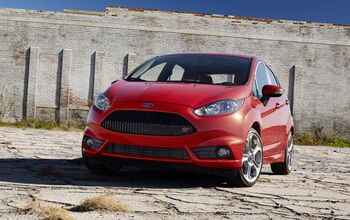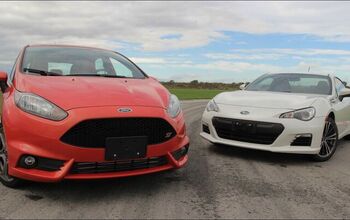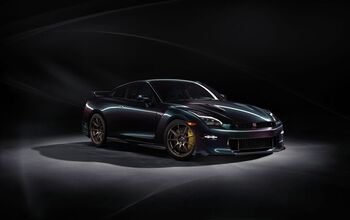2014 Ford Fiesta ST Review – Video

The term hot hatch is painfully over used. Any time a small five-door gets larger wheels, a mild bump in horsepower, or a slapped on body kit, people begin referring to it as a hot hatch. So what exactly is a hot hatch? Wikipedia claims a hot hatch ‘is a high-performance derivative of a car body style consisting of a three- or five-door hatchback automobile.’ That definition is broader than describing Ayrton Senna as a ‘driver’.
FAST FACTS
| 1. Power comes from a 1.6L turbocharged four cylinder developing 197 hp and 202 lb-ft of torque. |
| 2. The only transmission available is a six-speed manual. |
| 3. The Fiesta ST begins at $22,195 including destination charges. |
| 4. Fuel economy is officially rated at 26 mpg city and 35 mpg highway. |
That said, I’ll take a stab at my own definition. To me, a hot hatch is an otherwise pedestrian three or five door vehicle with enough performance to match that of a sports car within the same price range. Some hot hatches that come to mind are the Ford Focus ST, Subaru WRX STi and Mazdaspeed3. And now, there is one more, the Ford Fiesta ST.
THE BABY ST FINALLY IMMIGRATES
After years roaming European streets with a swarm of other high performance subcompact competitors, Ford is finally bringing the Fiesta ST to North America. As if the compact Focus ST wasn’t enough, the blue oval wants everyone to know that the manufacturer is serious about hot hatches; and we are all better for it.
SEE ALSO: 2013 Ford Focus ST Review – Video
The ST Fiesta features Ford’s 1.6-liter EcoBoost four-cylinder engine, jacked up with overboost to achieve an impressive 197 hp and 202 lb-ft of torque. That is a serious amount of power for a vehicle only weighing 2,742 lbs.
Get the Flash Player to see this player.
In fact, that’s more power than a MINI Cooper S and more torque than a Scion FR-S. The only vehicle in the Fiesta’s price and weight range that can beat it on power is the Hyundai Veloster Turbo. However, the supposed power deficit exists on paper only as the ST feels far more powerful throughout the rpm range than the little Hyundai. There is no lag in the Fiesta as the power builds up; an issue that plagues the Veloster Turbo. And it is not just compared to the Veloster that this motor feels punchy; it pulls just as hard as the far more powerful, albeit heavier Focus ST.
HEAR THAT LITTLE TURBO ROAR
Like most high performance Fords currently on sale, the ST has a sound symposer that blasts engine intake noise directly into the cabin. Step on the throttle hard and a nice throaty tone bellows into the cabin. The growl seems more noticeable in this subcompact hatchback than in the Focus ST, but nearly disappears during more relaxed driving.
SEE ALSO: Focus ST Handling Secrets Revealed
Getting the power to the front wheels is a conventional six-speed manual transmission that works in conjunction with an electronic front differential to minimize torque steer and wheel spin. The electronic wizardry does not stop there as, again like the larger Focus ST, the Fiesta ST comes equipped with three modes of stability control and can be put into, standard, sport or full-off. In any of these modes, the system will individually brake each wheel to help the driver rotate the car through the corner.
CHASSIS TRANSFORMATION
The rear suspension has been stiffened up compared to the regular Fiesta’s to reduce body roll and further assist while cornering. To ensure the vast amounts of electronic and mechanical handling upgrades are transferred to the road surface, the ST rides on 205/40R17 super-sticky Bridgestone Potneza RE050A summer tires that provide tremendous amounts of grip, but with a treadwear rating of only 140, will wear out quickly.
Ford has modified the Fiesta ST’s steering to be more direct and responsive. We were able to drive the Fiesta ST back-to-back with the regular Fiesta and difference in the quickness of the steering and the feedback is immense. The ST’s upgraded steering communicates what’s happening on the road ‘right now’ instantly into your hands.
There is one casualty to all of these chassis and suspension upgrades though; ride comfort. The ST crashes over larger road imperfections and expansion gaps are felt though every inch of the vehicle’s body. Although this type of behavior should be expected from a sporty special like the ST, it’s worse than usual in this little Ford and any potential buyer should be prepared to live with it.
OH THOSE SEATS!
Inside, the ST has a few premium upgrades like a leather-wrapped steering wheel, leather wrapped shift knob, aluminum pedals and the ambient lighting system found in the titanium Fiesta. It is worth the $1,995 to upgrade to the Recaro seat package as the partial leather, two-tone, super supportive, sculpted seats ensure the driver will not move, at all, during hard cornering; assuming of course the driver in question fits in the seats to begin with. Like the Focus ST’s Recaro seats, these Fiesta Recaros do not fit every body type.
Dominating the ST’s center stack is a 6.5-inch touchscreen featuring the latest version of MyFord Touch and available navigation. Aside from the push button start, the rest of the interior is pretty similar to a Fiesta titanium, which means a stylish upscale interior usually not found in the class if vehicle. The ST also retains the five-passenger seat configuration of regular Fiestas and is still rated at over 10 cu-ft of rear cargo space, although it is split up by a shelf thanks to a full size spare tire.
LOOKS THE PART
Hot hatches also need to look the part and Fiesta ST is no exception. Ford has given it a unique front grille, hood, lower front spoiler, rear diffuser, larger spoiler, dual tip exhaust and what Ford calls a fascia extension. All STs will ride on a choice of two different 17-inch wheel packages wearing low profile summer tires, that combined with a 15 mm lower ride height gives the ST a mean stance.
As a bonus, the Fiesta ST is also rather efficient for the amount of performance it posses with official fuel ratings of 26 mpg city and 35 mpg highway. However, we have a feeling most owners of this car will be well into the boost, a lot of the time, and achieve nothing close to these projections.
But the best feature of the Fiesta ST may well be the price. Beginning at just over $22,000 after destination charges, the ST may well be the performance bargain of the decade. That price undercuts the Hyundai Veloster Turbo and Scion FR-S. Be careful though, get a little crazy checking off option boxes and the Fiesta can easily approach $27,000.
THE VERDICT
And that brings us to the competition. The two main rivals for the Fiesta ST are the MINI Cooper S and the Chevrolet Sonic RS. But, with a pathetic 138 hp, the RS is not really a hot hatch and the Cooper S is more upscale than this Ford.
The Veloster Turbo matches up well with the ST in terms of power, price and features, but it lacks in raw sportiness to such a significant degree that, at first, we even forgot it was in the same class.
And for those reasons it’s obvious the rambunctious Fiesta ST really is in a class of its own.
This baby demon indeed lives up to the hype, and with its smaller dimensions, lighter weight and cheaper price tag, I like it even more than the Focus ST.
LOVE IT
- Power
- Price
- Handling
- Front seats
LEAVE IT
- Ride quality
- Rear seat space

A 20+ year industry veteran, Mike rejoins the AutoGuide team as the Managing Editor. He started his career at a young age working at dealerships, car rentals, and used car advertisers. He then found his true passion, automotive writing. After contributing to multiple websites for several years, he spent the next six years working at the head office of an automotive OEM, before returning back to the field he loves. He is a member of the Automobile Journalists Association of Canada (AJAC), and Midwest Automotive Media Association (MAMA). He's the recipient of a feature writing of the year award and multiple video of the year awards.
More by Mike Schlee































Comments
Join the conversation